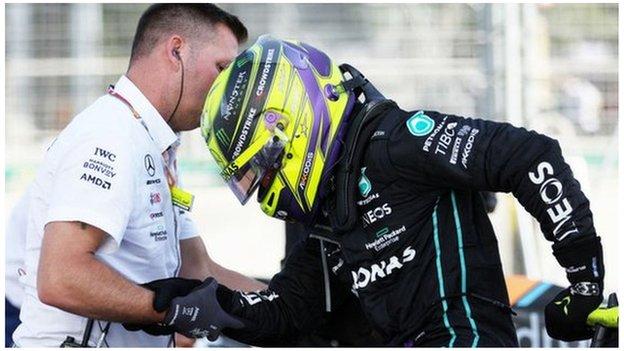
Mercedes driver George Russell says changes aimed at addressing Formula 1’s “bouncing” problem are “more of a sticking plaster than the solution”.
This came after drivers urged the FIA to take action because of concerns the problem was risking their health.
And Russell said that “bigger conversations are definitely needed” to find a comprehensive solution.
He added: “The vertical loads are far beyond what you’d expect is safe to deal with.”
The bouncing problem has arisen following new rules introduced this year in an attempt to improve the racing.
These have re-introduced a phenomenon known as “ground effect”, which requires cars to be run very stiff and as low as possible for maximum performance.
And over the course of the first eight races it has become clear that this is creating physical problems for the drivers.
There are two related but separate issues – “porpoising”, an aerodynamic phenomenon caused by underbody airflow disruption, which leads to a high-frequency vertical oscillation; and “bouncing”, caused when the cars’ floors hit the track.
Some teams are suffering worse than others, but drivers from all teams are believed to have expressed their concerns on the issue.
Aston Martin’s Lance Stroll was forced to retire from last weekend’s race in Azerbaijan because of the severity of the problem, the first time this has happened to a driver this season.
The Canadian said: “It has been very bad and both porpoising and the stiffness is something the FIA needs to address because it’s not sustainable.”
His team-mate Sebastian Vettel added: “It can’t be that us drivers should suffer injury short or long term, or possibly for the rest of our lives, every sport to the extreme is not healthy.
“But it cannot go on for another four or five years like that so it is good the FIA is looking into it.”
Championship leader Max Verstappen said: “I don’t think rule changes in the middle of the season are correct, I understand the safety aspect but if you raise your car you will have less issues. Naturally you will find the limit of what you can cope with.”
However he admitted porpoising was “not nice and not correct, but I don’t think we should over-dramatise it, because we have a lot of smart people who can get rid of these things”.
Mercedes’ Lewis Hamilton said: “It is always interesting seeing people’s perspectives and opinions – in front of you [the media] it’s one thing and in the background sometimes people say different things.
“Safety is the most important thing and at least one driver in every team has spoken about it.
“I don’t think it is going to change a huge amount but a lot needs to be done on it. It’s not about coping with the bouncing for the next four years; it’s about fixing it so all of us don’t have back problems moving forward.
“In the drivers’ briefing at the last race pretty much every driver except for Fernando [Alonso] was commenting on it and complaining, even the Red Bull drivers were saying: ‘Yeah this is a problem, we have to work on it.’
“And then they are in front of the media here and they are saying a completely opposite thing.”
Hamilton said he experienced vertical loads of 10G during the Baku race.
He and Verstappen said that F1 and the FIA had not anticipated these problems would occur to such an extent when they worked on the new rules.
What has the FIA done?
The FIA has introduced a technical directive saying that it considers “high levels of grounding or excessive aerodynamic oscillations a ‘dangerous construction’.”
It pointed out that the stewards “can disqualify cars deemed to be dangerous”.
And it has set out a series of steps with which it plans to address the problems over coming races.
These include:
- Analysing the wear and skid patterns on the cars’ underfloors
- Defining a metric to “provide an objective criterion” for these oscillations which will lead to the establishment of an “acceptable” level
- Over a period of races, this will lead to teams having to submit an aerodynamic configuration for their cars after final practice that can then not be changed other than under a few pre-defined areas.
For next season, the FIA told teams in the directive, which is not publicly available but which has been seen by BBC Sport: “The objective is to implement changes for 2023 which will inherently reduce the propensity of the cars to exhibit aerodynamic oscillations.”
As part of this, they will assess technical changes, including “raising the floor edges, reduction of the floor planform, [elimination] of floor edge wing etc”.
Teams can take measures for Canada this weekend including adding an additional floor stay, or adding additional thickness to the floor.
